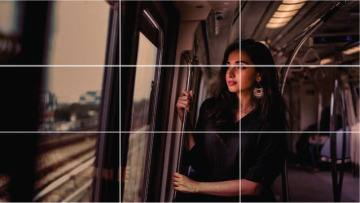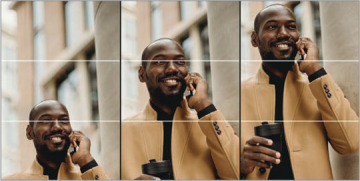Framing and the Rule of Thirds
Camera framing is how the frame is positioned around the elements in an image. We also use the term to describe how an element within the image is positioned relative to the frame. As we learned from Molly Bang, objects in the center of the frame have the most power, but objects at the edges are more interesting. What I’ve discovered is that our eyes get bored when a subject is placed dead-center. We quickly start exploring the rest of the frame to see what else there is to see. However, images placed toward the edge have a dynamic about them that keeps drawing the eye.
This observation isn’t unique to me; the Dutch master painters in the 1600s discovered and popularized it through their paintings. Like the 180° Rule, this, too, has its own name: the “Rule of Thirds.” This is another important concept that will recur throughout this book.
The Rule of Thirds divides the screen into three equal rows and columns (Figure 2.27). Important elements of the image should be placed either at one of the four intersections or along one of the lines to create a pleasing, dynamic visual balance.

FIGURE 2.27 A shot framed according to the Rule of Thirds. Notice, also, that she is framed so she has lots of “looking room.” (Image Credit: Mentatdgt / pexels.com)
As you look at Figure 2.27, notice that the woman is not centered. In fact, she is looking “into” the frame, with her body positioned on the side of the frame opposite to where she is looking. This space between her eyes and the left or right edge of the frame is called “looking room.”
When I first presented the concept of the frame, I mentioned that it fools the brain into thinking that only that portion of the image that we see in the frame exists. Looking room reinforces this.
Compare the emotional difference between Figure 2.27 and Figure 2.28. In real life, both are in a similar environment—looking out a train window. However, the image of the woman with lots of looking room feels “normal,” while reducing the looking room makes the shot of the man feel like he is running out of options. The framing differences between these two shots vastly alters how we interpret the emotions in each shot.

FIGURE 2.28 When the looking room is reduced, the subject feels cramped, pressured, or trapped. (Image Credit: Guilherme Rossi / pexels.com)
In addition to looking room, which adjusts the horizontal distance between the subject and the sides of the frame, there’s also “head room,” which is the distance between the top of a subject and the top of the frame. Here, too, the Rule of Thirds holds sway.
In general, you want the central focus of the subject placed on the upper Rule of Thirds line. In the case of a close-up of a person’s face, that means putting their eyes on the line.
Figure 2.29 illustrates a common problem with amateur photographs: too much, or too little, headroom. If the man is the subject of the photo, as opposed to the building behind him, put his eyes on the top line of the Rule of Thirds.

FIGURE 2.29 Three examples of headroom: too much (left), too little (right), and just right (center). The white lines indicate the horizontal lines from the Rule of Thirds. (Image Credit: Cottonbro / pexels.com)
Another problem, shown in Figure 2.30, is putting the face of the subject in the center of the frame. In both shots, the man’s head is the same size. Yet, look at how much more substantial and forceful the image on the right is. The only change was moving the eyes from the center of the frame to the top Rule of Thirds line.

FIGURE 2.30 The size of his face is the same; all that’s changed is moving the face from the center of the frame (left) to the top Rule of Thirds line (right). (Image Credit: Malcolm Garret / pexels.com)
Eye Contact Is Nontrivial
Earlier in this chapter, I discussed the concept of the “fourth wall.” This is the assumption that the audience is invisible to the subjects in an image; they are “hiding behind a wall.”
The images in Figure 2.31 make this concept vividly clear. In the left image, we are viewers. In the right image, we are participants. With the image on the left, the audience is invisible, watching a little boy play with a camera and a soccer ball. It’s the type of scene to make a parent smile; because the kid is so caught up in what they are doing, they’ve tuned out everything around them.

FIGURE 2.31 Note the emotional difference between looking into the frame and being looked at. (Image Credit: Tuán Kiêt Jr. / pexels.com)
However, the image on the right, where the boy’s eyes connect directly with the camera, means the audience is no longer invisible; we are directly involved in what’s happening in the scene.
This is another important concept. You can’t have talent looking at the camera in one shot and not looking at it in the next shot. It is disjointing to the audience. We don’t know what our role is: Are we viewers or participants? Pick one option and stick with it. This popular, but unsettling, trend of bouncing between eye contact and no eye contact has diminished the impact of many interviews.
Cropping is the process of removing portions of the image, either to get rid of garbage in the shot or to alter the framing. When you crop an image (Figure 2.32), don’t cut someone at body joints, meaning their neck, elbows, wrists, or waist. It is much more pleasing, as Figure 2.32 illustrates, to crop images elsewhere on the body.

FIGURE 2.32 Notice how much more pleasing the framing is if you don’t cut someone at body joints. (Image Credit: Italo Melo / pexels.com)
Symmetry vs. Balance
There’s a big difference between symmetry and balance. Symmetry is where both sides of an image are the same, as shown in Figure 2.33. Balance is where the “weight” of images on one side of the frame “balance” those on the other side. This picks up on ideas we first learned from Molly Bang, earlier in this chapter. Symmetry creates lovely images, but balance is more compelling.

FIGURE 2.33 The symmetry in this photo creates a stunning visual, but, the eye quickly gets bored and looks elsewhere. (Image Credit: pexels.com)
In Figure 2.33, both sides of the image are symmetrical. It’s lovely to look at, but our eyes quickly start looking for something else. There’s too much emphasis on the center of the frame.
See how quickly you stopped looking at the architecture and shifted to the next image to check out the rocks?
We also saw this problem with symmetry in Figure 2.27, with the woman in the black jacket walking up from the beach. She was in the center of the frame, but our eye quickly got bored with the subject in the center.
In Figure 2.34, balance combines with the Rule of Thirds to create a much more compelling image. We see the rocks first, because they are bigger. Then, we start exploring elsewhere in the frame, but we keep coming back to the stack of rocks. That’s the power of the balance—creating dynamic images that capture the eye while allowing it to explore the frame in more detail.

FIGURE 2.34 These rocks, while off-center (though still framed according to the Rule of Thirds), make for a much more compelling image. (Image Credit: pexels.com)
As another example of balance, the tree image in Figure 2.35 has a number of elements going for it: The tree is brighter than the background, is bigger than other trees near it, is framed according to the Rule of Thirds, and contains different colors when compared to the background. The eye is automatically attracted to it! (The streaks of sunlight serving to backlight it help, too.)

FIGURE 2.35 Another example of balance, with the brightness of the tree balanced by the heavier, darker woods on the left. (Image Credit: Ray Bilcliff / pexels.com)
The Weirdness of Right-Handedness
There’s a fascinating psychological quirk: right-handedness. Readers of Western languages also tend to “read” images from left to right—the same as a book. This means that our eyes give more weight to where they finish looking (the right side) than where they start (on the left). This often affects how we interpret images.
In Figure 2.36 the photo was flipped horizontally. When it did, the meaning changed. In the left image, we see the opening first; in the right image, we see the man first. Why? Because in both cases, our eye gave more weight to the right side of the image, then we used the right side of the image to interpret the meaning of the complete image.

FIGURE 2.36 Here’s the same photo. Flipping the image changed the meaning. (Image Credit: Marius Venter /pexels.com)

